最新人教版七年级下册英语全国英语素养大赛一等奖教学设计12.2
人教版七年级英语下册unit12优秀教案

人教版七年级英语下册unit12优秀教案全文共3篇示例,供读者参考篇1Unit 12 of the People's Education Edition Grade Seven English textbook covers the topic of art and creativity. In this unit, students will learn about different forms of art, discuss their favorite types of art, and participate in various creative activities to express themselves.To make the most of this unit, here is an excellent lesson plan that teachers can follow:Lesson 1: Introduction to ArtObjective: To introduce students to the concept of art and its different forms.Activities:1. Show examples of different types of art such as paintings, sculptures, and music.2. Brainstorm with students about what art means to them and what forms of art they enjoy.3. Discuss the importance of art in society and how it can bea form of self-expression.Lesson 2: Famous ArtistsObjective: To learn about famous artists and their works.Activities:1. Introduce students to well-known artists such as Leonardo da Vinci, Vincent van Gogh, and Pablo Picasso.2. Show pictures of their famous works and discuss the style and themes of their art.3. Have students choose a favorite artist and create a poster about their life and works.Lesson 3: Creating ArtObjective: To engage students in creative activities to express themselves.Activities:1. Provide art supplies such as paints, crayons, and paper for students to use.2. Encourage students to create their own artwork inspired by the styles of famous artists or their own imagination.3. Have a mini art exhibition in the classroom to showcase students' works.Lesson 4: Reflecting on ArtObjective: To reflect on the role of art in our lives and society.Activities:1. Have a class discussion about how art can inspire, entertain, and provoke emotions.2. Ask students to write a reflection on what art means to them and how they can incorporate more art into their lives.3. Watch a short video about the impact of art on society and discuss its importance.By following this lesson plan, teachers can effectively cover the content of Unit 12 and engage students in meaningful discussions and activities related to art and creativity. This will not only help students improve their English skills but also develop their appreciation for art and the creative process.篇2Unit 12 of the People's Education Press seventh grade English textbook is focused on the theme of "Life in the future".In this unit, students will learn how to talk about their future plans, aspirations, and predictions. Here is an excellent lesson plan for teaching Unit 12 of the textbook:Lesson Plan:Title: Life in the futureGrade: 7Unit: 12 (People's Education Press)Theme: Future plans, aspirations, and predictionsDuration: 2 lessons (90 minutes each)Objectives:- Students will be able to talk about their future plans using the simple future tense.- Students will be able to express their aspirations for the future.- Students will be able to make predictions about the future using future tense modal verbs.- Students will be able to write a short paragraph describing their future plans.Warm-up (15 minutes):- Begin the lesson by asking students to brainstorm and discuss what they think life will be like in the future. Encourage them to think about technology, education, careers, and daily life.- Play a short video or show pictures of futuristic inventions and ask students to describe what they see.Presentation (30 minutes):- Introduce the simple future tense to students and explain its formation (will + base verb).- Give examples of how to talk about future plans using the simple future tense.- Practice with students by asking them to talk about their own future plans using the simple future tense.- Introduce future tense modal verbs (will, might, may) for making predictions about the future.- Give examples of how to make predictions using future tense modal verbs.Practice (30 minutes):- Divide students into pairs and ask them to discuss and write down their future plans using the simple future tense.- Monitor and provide assistance as needed.- Ask some pairs to share their plans with the class.Production (15 minutes):- Ask students to write a short paragraph (5-7 sentences) describing their future plans using the simple future tense.- Provide a writing prompt to help guide students in their writing.- Allow students to share their paragraphs with the class.Review and Assessment (15 minutes):- Review key concepts and vocabulary from the lesson.- Ask students to complete a short quiz or worksheet to assess their understanding of the simple future tense and future tense modal verbs.- Provide feedback and address any misconceptions.Homework:- Assign students to write a diary entry about a day in their future life using the simple future tense.By following this lesson plan, students will be able to effectively communicate their future plans, aspirations, andpredictions in English. This lesson plan incorporates various activities to engage students and reinforce key language concepts related to the theme of "Life in the future" in Unit 12 of the People's Education Press seventh grade English textbook.篇3Unit 12: You’re supposed to shake handsTeaching Objectives:1. Students will be able to understand the cultural differences in greetings between different countries.2. Students will be able to use the target language for greetings appropriately.3. Students will be able to reflect on the importance of cultural understanding and respect.Teaching Procedures:Step 1: Warm-up (10 minutes)- Begin the class by showing a video clip of people from different cultures greeting each other. Ask the students to share their thoughts on the various greetings they saw.- Discuss the importance of greetings in different cultures and how they can vary from country to country.Step 2: Presentation (15 minutes)- Introduce the target language for greetings and practice pronunciation with the students.- Show a slideshow or video presentation of common greetings in different countries, emphasizing the cultural significance of each greeting.- Have students take notes on the different greetings and their cultural meanings.Step 3: Practice (20 minutes)- Divide the class into pairs or small groups and have them practice the target language greetings with each other.- Encourage students to think about the appropriate greetings for different situations (formal vs. informal, meeting strangers vs. meeting friends).- Monitor and provide feedback as needed.Step 4: Cultural Understanding (15 minutes)- Engage the students in a discussion about the importance of cultural understanding and respect when greeting others.- Ask students to reflect on a time when they may have misunderstood a greeting in a different culture and how they could have handled the situation better.- Encourage students to think about ways they can show respect for other cultures in their daily lives.Step 5: Review and Assessment (10 minutes)- Review the target language greetings with the whole class and assess student understanding through a quick quiz or game.- Encourage students to continue practicing their greetings outside of the classroom and to explore more about different cultures and their greetings.Homework:- Ask students to research a different culture and its traditional greetings, and to write a short reflection on what they learned.By following this detailed lesson plan, students will not only learn the target language for greetings but also gain a deeperunderstanding of the importance of cultural awareness and respect.。
最新人教版七年级英语下册全英文教案(全册全英文)

最新人教新目标七年级英语下册全英文教案(全册全英文)Unit 1 Can you play the guitar?教学过程♦ Step 4 Role-play1.Ask the students to read the conversation in 2d.try to find: What can Jane/ Bob do?What club do they want to join?2.Ask the students to fill in the forni.(见课件)3.Ask students to practice the conversation according to the for m・4.Ask students to perform the conversation.♦Step 5 Explain several important words and phrases.(见课件)♦Step 6 HomeworkMake a survey about what your friends can do and what club your friends want to join. 板书设计Unit 1 Can you play the guitar教学过程Example:In my group,Li Lin can do kung fii.Liu Kun can tell stories....Fm sure we will give you a good show and make you have a good time・♦ Step 6 HomeworkWrite an ad—Students Wanted for Our Learning Group・板书设计Unit 1 Can you play the guitar4.Ask students to read the passages in 2b.And then match the titles with the ads・5.Check the answers・6.Who fits the job? Match each person in 2a with an ad in 2b.Write A.B and C.(见・课件)7.Check the answers・♦Step 5 Explain important points.♦Step 6 HomeworkWrite a letter to your. teacher.Tell him/lier what you can do for school concert・板书设计课堂练习I •根据汉语意思完成句子1.你能帮我学英语吗?____ you help me ________ English?2.你善于和老人相处吗?____ you ______________ old people?Unit 1 Can you play the guitar(3)hclp⑷be good at/witli/for的用法与区分Work on Self Check 3Ask several students to show their works.♦ Step 5 HomeworkWrite a poster:Artist Wanted for Art Festival.板书设计课堂练习I •单项选择1 ・ Peter __ play soccer・A.can alsoB.also canC.can tooD.too can2.___ you good ______ c hildren?A.Are;forB.Is;in.C.Are;atD.Are;with3.Please call Mr.White ____ 589-267.A.inB.atC.onD.with4.― an you sing or swim?A.YesJ can swimB.NoJ can't swimC.YesJ can singD.I can sing5.___________________________ We want two good actors our school show.Unit 2 What time do you go to school?Keys:(l )From 12:00 at night to 6:00 in the morning. (2)At eight thirty at night. (3) At nine. (4) At ten twenty.(5) At elev亡n o'clock.3.Ask students to practice the conversation in 2d in pairs.教学过程板书设计课堂练习I .根据句意及首字母提示完成单词I・一What t _ da you go to school?—At &00.2.1usually get u ____ at 7:00 every day.What about you?3.__________________________________ My mother bought me two red d on my birthday.4.1need a new b _____ and some new pencils to draw the picture・5.1usually take a s ____ before I go to bed・Keys: 1.time 2.up 3.dresses 4.brush 5.showcrII.用所给词的适当形式填空1. A man has twenty-eight ______ (tooth)・2.Mrs.Li _____ (dress) little Tom every morning.3.My father ______ (work) in a shoe factory.4.Mr.Wang tells us a _____ (fun) story in class.5.1do morning ______ (exercise) with my grandparents every day.Unit 2 What time do you go to school♦Step 2 Learning Grammar Focus1.Ask students to read the sentences in Grammar Focus and translate them into Chinese.,2.Explain several important points・3.Ask students to do some exercises.(见课件)♦Step 3 Writing sentences1 .Work on 3a.Ask the students to write answers or e always,usually or never.2.Ask the students to show the answers.3.Let students write something they always/usually/never do on the blackboard・4.Ask students to do an interview with three students.Find out what time they do the activities in 3c.Then give a report. For example:In our group.Li Fei usually gets up late on weekends.She gets up at...♦Step 4 Explain several important words and phrases.(见课件)♦Step 6 HomeworkWrite an article to mtrodnee your classmate's daily activities.板书设计课堂练习I .根据句意及汉语提示写单词1 .This is a big train (火车)(站)・2.Lily ____ (从不)buys green clothes.3.You don't need to go to school ______ (早地)next Monday.4.The _____ (收音M) player is very nice・5.We have lunch at twelve _______ (点钟).Unit 2 What time do you go to school教学过程♦Step 4 Explain several important points.♦Step 5 HomeworkWrite a passage about your daily life.板书设计课堂练习I .单项选择I.Can you help us do _____ ?A.our homeworksB.our homework homeworks homework2.We go home at half _____ five ______ t he aftemoon.A.to;inB.past;atC.to;atD.past;in3.What time do you eat _____ breakfast? What do you usually have _______ breakfast?A./;/B.for;forC./;forD.for74.1 like to eat __ apples _____ pears.but not grapes・A.either;orB.neither;norC.not only;butD.or;or5.____________ The cake good.I w^nt another one・A.feelsB.tastesC.soundsD.feelsKeys:l—5BDCABII•根据汉语意思完成句子Unit 2 What time do you go to schoolUnit 3 How do you get to school教学过程♦ Step 4 Work on 2dStudent A is Jane and Student B is e the information in 2b to make conversations.A:How do you get to school?B:L・・A:How long does it take...?B:It takes...A:How far is it from...to...?Bit's about...♦Step 5 ReadingAsk students to read the dialogue in 2e and translate it into Chinese.Then ask students to role-play the dialogue. ♦Step 6 HomeworkPractice the conversation in 2c.板书设计课堂练习1.根据句意及汉语提示写单词1 Jim is not happy because he lost his _____ (自行车).2.There are always lots of people on the _____ (公共汽车).3.My aunt takes the ____ (地铁)to work every day.4.—How do you get to Beijing?—I take the ____ (火车).5.1 usually _____ (步行)to school in the morning・Keys: 1.bike 2.bus 3.subway 4.train 5.walkUnit 3 How do you get to school教学过程♦ Step 4 Make a survey 3cl.Show a chart on the screen.(2.Let students ask their classmates questions and write their names in the chart.The firs4 student to fill in all the blanks wins.3.Ask several students to show their results in front of the class・板书设计课堂练习I •单项选择l.____________ How far is from Hangzhou to Wuhan?A.thatB./C.itUnit 3 How do you get to school教学过程4.Check the answers.(见课件)①They go on a ropeway to cross the river to school.②Because they don't have a bridge over die Tiver.③Yes.he does.Because he loves to play with his classmates and he loves his teacher.④The dream is that there .is a bridge over the river.I think their dream can come true.Because all the villagers are working on it.5.Ask the students to read the passage again and complete the sentences in 2c with words from the passage・6.Check the answers・(l)difficult (2)big (3)quickly (4)afraid (5)truc♦ Step 5 HomeworkWrite a short passage about how your classmates go to school.板书设计课堂练习I •根据句意及首字母提示完成单词1.____________ Linda's h is far from her school.2.She t ____ the No.16 bus to school every day.Unit 3 How do you get to school2.F inish Self Check 2.Ask students to write at least five questions with the information in the chart.Then answer thequestions・For example:—How does Tony get to school?—He gets to school by bike・♦ Step 5 HomeworkWrite a passage with t he information in Self Check 2.板书设计课堂练习I•根据汉语意思完成句子1.Mike often _________________ (坐火车)to Beijing.2.Let's go there __________ (乘小汽车).3.My teacher ____________ (像)a friend to me.4.Mrs.Li has _________________ (—个八岁大的)daughter.5.1 eat fruit and vegetables ___________ (每天).6. _ ________ (多长时间)does it take Zhao Lei to do his homework?Keys: 1.takes the train 2.by car 3.is like 4.an eight-year old 5.cvcry day 6.How long II•根据句意,用合适的介词填空1 ・一What do you think _____ the travel?―reat.2.It is about two kilometers ____ my home _______ school.3.Thursday is ____ Wednesday and Friday.4.Jane often goes to school _____ t rain.5.___ many studentsat is easy to get to school. Keys: 1 .of 2.from;to 3.between 4.by 5.For教学反思Unit 4 Don't eat in class.教学过程2.Check the answers.(见课件)(1)It’s not to be late for class.We must be on time.(2)No.they can't.(3)No.they have to wear the school uniform.3.Let students role-play the conversation in 2d in pairs ♦ Step 6 HomeworkWrite the rules in your home.板书设计课堂练习I .根据句意及首字母提示完成单词I.It's very i __ for students to learn English well.2.We must be g _____ in the library.3.We can't eat ill the classroom but we can eat o _____ ・4.Doift a ____ late for class next time.5.Lily w _____ a red dress today.Keys: 1 .important 2.quiet 3.outside 4.arrive 5.wearsII.单项选择1.Don't be late ___ school.A.onB.forC.inD.at2.—Doni eat in the classroom.—__ ,Miss Liu.A.TlianksB.ReallyC.SorryD.Why3.We can't Jisten to music in the classroom. _____ we can do it in the hallways.A.andB.butC.soD.or4.― an I wear hats in class?—__ .but you can wear them after class・A.YesJ canB.Yes.you doC.NoJ can'tD.No,yon cant5.Rose _____ to school very early every day.A.arrivesB.getsC.reachesD.arriveKeys: 1—5 BCBDB教学反思Unit 4 Don,t eat inclass教学课题Section A (Grammar Focus-3c)教学目标【知识目标】Important phrases:wear a hat.wear a uniformImportant sentences:1 Don't run in die hallways.2.—What are the rules?—We must be on time for class・3.― an we eat in the classroom?—No,we can5t,but we can eat in the dinmg hall.4.—Docs he have to wear a uniform at school? ―Yes.he does./ No.he doesn't.5.—What do you have to do?—We have to be quiet in the library.教学重难点【能力目标】1.学会使用祈使句。
最新人教版七年级下册英语全国英语素养大赛一等奖教学设计12.3
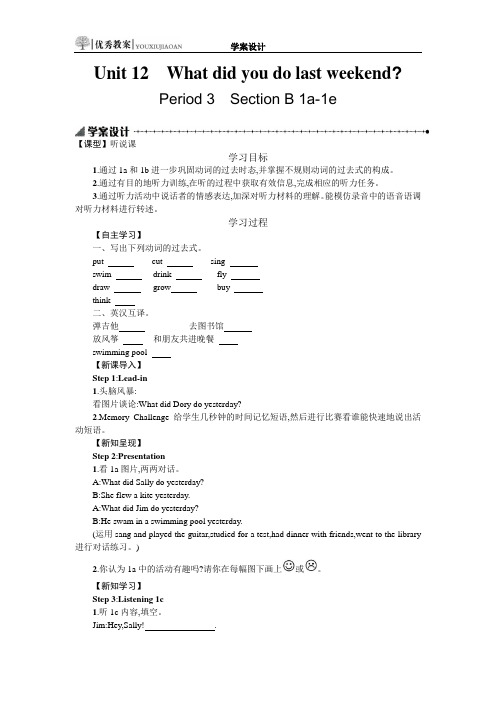
Unit 12What did you do last weekend?Period 3Section B 1a-1e【课型】听说课学习目标1.通过1a和1b进一步巩固动词的过去时态,并掌握不规则动词的过去式的构成。
2.通过有目的地听力训练,在听的过程中获取有效信息,完成相应的听力任务。
3.通过听力活动中说话者的情感表达,加深对听力材料的理解。
能模仿录音中的语音语调对听力材料进行转述。
学习过程【自主学习】一、写出下列动词的过去式。
put cut singswim drink flydraw grow buythink二、英汉互译。
弹吉他去图书馆放风筝和朋友共进晚餐swimming pool【新课导入】Step 1:Lead-in1.头脑风暴:看图片谈论:What did Dory do yesterday?2.Memory Challenge 给学生几秒钟的时间记忆短语,然后进行比赛看谁能快速地说出活动短语。
【新知呈现】Step 2:Presentation1.看1a图片,两两对话。
A:What did Sally do yesterday?B:She flew a kite yesterday.A:What did Jim do yesterday?B:He swam in a swimming pool yesterday.(运用sang and played the guitar,studied for a test,had dinner with friends,went to the library 进行对话练习。
)2.你认为1a中的活动有趣吗?请你在每幅图下画上或。
【新知学习】Step 3:Listening 1c1.听1c内容,填空。
Jim:Hey,Sally!.Sally:Yeah,I stayed at home on Saturday.I was quite busy.Jim:Why?Sally:.Jim:Like what?Sally:Well,I did my homework and studied for a test.Jim:You did?Not much fun,huh?Sally:Well,.On Sunday I went to the library.How about you?Did you go out?Jim:Well,I sang and played the guitar on Saturday morning.On Sunday afternoon,I flew a kite in the park.And on Sunday night,I had dinner with my friends.Sally:Wow!!2.听录音,完成表格信息。
最新人教版七年级下册英语全国英语素养大赛一等奖教学设计2.4
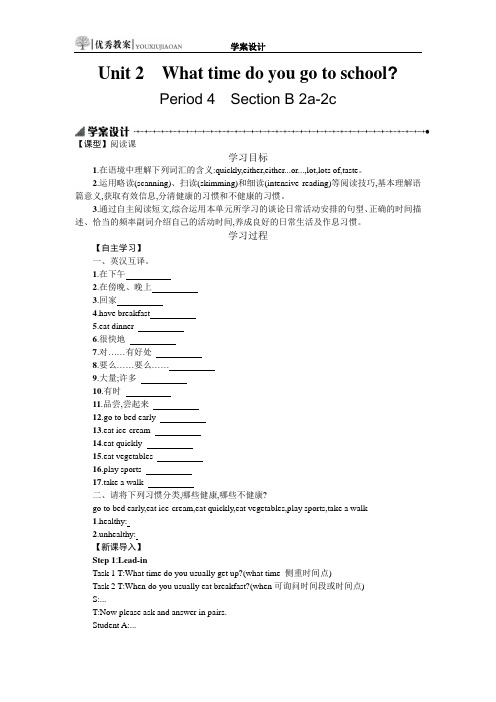
Unit 2What time do you go to school?Period 4Section B 2a-2c【课型】阅读课学习目标1.在语境中理解下列词汇的含义:quickly,either,either...or...,lot,lots of,taste。
2.运用略读(scanning)、扫读(skimming)和细读(intensive reading)等阅读技巧,基本理解语篇意义,获取有效信息,分清健康的习惯和不健康的习惯。
3.通过自主阅读短文,综合运用本单元所学习的谈论日常活动安排的句型、正确的时间描述、恰当的频率副词介绍自己的活动时间,养成良好的日常生活及作息习惯。
学习过程【自主学习】一、英汉互译。
1.在下午2.在傍晚、晚上3.回家4.have breakfast5.eat dinner6.很快地7.对……有好处8.要么……要么……9.大量;许多10.有时11.品尝,尝起来12.go to bed early13.eat ice-cream14.eat quickly15.eat vegetables16.play sports17.take a walk二、请将下列习惯分类,哪些健康,哪些不健康?go to bed early,eat ice-cream,eat quickly,eat vegetables,play sports,take a walk1.healthy:2.unhealthy:【新课导入】Step 1:Lead-inTask 1 T:What time do you usually get up?(what time 侧重时间点)Task 2 T:When do you usually eat breakfast?(when可询问时间段或时间点)S:...T:Now please ask and answer in pairs.Student A:...Student B:...【新知呈现】Step 2:Presentation1.T:In our lives,some activities are healthy.For example:Take a walk after dinner.Exercise every morning.Go to bed early and get up early.2.BrainstormingLet’s work in groups.Talk about what a ctivities are healthy;what activities are unhealthy. Make a list on a piece of paper.Then report your list to the class.3.Look at the activities,which are healthy and which are not.get up early eat ice-cream after dinnergo to bed late don’t brush t eetheat very quickly brush teeth after dinnerrun in the morning sometimes play sportstake a walk after dinner exercise before afternoon class【新知学习】Step 3:ReadingBefore reading1.Look at 2a and read the activities.2.Check the activities in 2a you think are healthy.While readingScanningRead quickly and answer the questions:1.Who are they?2.Who is healthier?3.When does Tony go to bed?4.When does Mary go to bed?Students read the passage quickly and try to find the answers to the questions. SkimmingTime Mary’s ActivitiesIntensive reading1.Students read the passage again and circle the healthy activities in the passage.2.Check the answers.3.Tell the students to read the passage again and write down the unhealthy habits of each person.Then think of healthy activities for them.Unhealthy habits Healthy activitiesTonyMary观察与思考通读全文,本文以为线索,贯穿全文,如:in the morning,,;另外一些时间短语,如:at ten thirty,等;除此以外,一些关联词,如:so,,等也可以使语言描述更有层次、更完整。
最新人教版七年级下册英语全国英语素养大赛一等奖课件新目标七下Unit 12 Period 3 课件
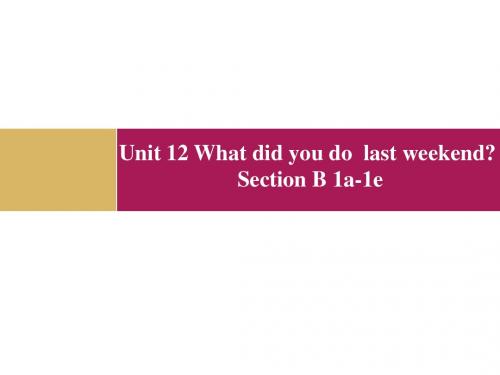
-18-
1b
Do you think the activities in 1a are fun?
A. it wasn’t too bad B. I didn’t do my homework, so school this morning wasn’t fun C. I didn’t see you last weekend D. You had a relaxing time E. I had a lot of things to do
-20-
1c What did Sally and Jim do last weekend? Complete the chart.
Sally Jim flew a kite in the park did her homework sang and played the guitar
studied for a test
4
visited friends
5
cleaned the room
studied
6
7
had lunch
8
went to the movies
9
read a book
10
wrote a letter to Nemo
geography
-16Here are some things that sally and Jim did 1a yesterday. Match the activities with the pictures.
最新人教版七年级下册英语全国英语素养大赛一等奖课件新目标七下 Unit 12 Period 1 课件1
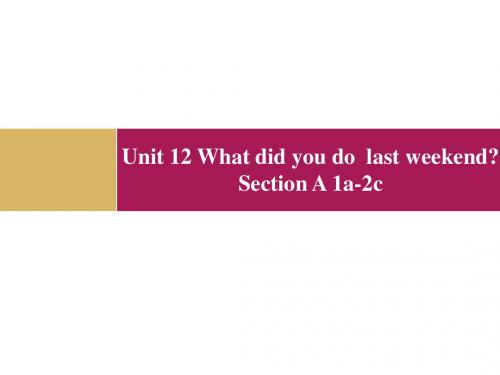
-5-
Listening
-61b Listen and write the day, morning, afternoon or night below each picture.
night
afternoon
Saturday
afternoon
morning
Sunday
-7-
听力提高 What did Lucy do last weekend?
Unit 12 What did you do last weekend? Section A 1a-2c
-2-
-3-
Free talk
Talk about your weekend.
watched TV
went boating
went to a farm
A: How was your weekend ? B: It was interesting. I played basketball.
Jack
fed __________some cows
2c
Student A asks questions with who, what or where and Student B answers. Then change roles.
-13-
两人一组,用疑问词who, what 和where就 2a的听力内容进行问答。
Becky Carol Jack
went to a farm
fed some cows
visited her studied for the grandma English test did her homework
A: Who visited her grandma? B: Becky did.
人教版英语七年级下册Unit12SectionA(2d–3c)教学设计

四、教学内容与过程
(一)导入新课
1.教师通过向学生展示一组生日庆祝的图片,引发学生对生日话题的兴趣,激活他们的背景知识。
“Boys and girls, look at these pictures. Can you guess what they are about? Yes, they are about birthday celebrations. Today we are going to learn something about birthday celebrations.”
3.运用一般现在时和一般过去时描述生日庆祝活动,帮助学生掌握时态的运用。
“When we talk about birthday celebrations, we can use both simple present tense and simple past tense. For example, 'I usually have a party on my birthday.' or 'I had a wonderful birthday party last year.' Let's practice some more sentences together.”
“Listen carefully to your classmates and give them your feedback. You can ask questions or make comments.”
(四)课堂练习
1.教师呈现3a部分的练习题,指导学生完成阅读理解任务。
“Now let's move on to 3a. Here is a reading comprehension exercise about birthday celebrations. Please read the passage and answer the questions.”
七年级下英语Unit 12—教学设计【教学参考】

Luo Xinghong
Topic
Unit12 What did you do last weekend? Section A (1a-1c)
Teaching Aims and Demands
Knowledge Learn and master the key words and target language. Objects Ability Train the Ss’ ability of listening, speaking, reading and Objects writing.
2. Let Ss use the phrases to
make a conversation
3. Ask some of groups to share 3. Ss share their conversation.
their conversations.
Listening(1b)
Listening(1b)
1c,key conversation
1c,key conversation
1. Ss listen to the passage
1. T: Last weekend I was very carefully.
七年级下英语 Unit 12—教学设计【教学参考】
busy. On Saturday morning, I
played badminton
…
morning on Saturday afternoon.
Sunday evening night
Ⅷ.Reflection
七年级下英语 Unit 12—教学设计【教学参考】
七年级下英语 Unit 12—教学设计【教学参考】
新人教版七年级下册英语全册优质教学设计

Unit 1 教学设计Title Unit 1 Can you play the guitar?Teaching aimsKnowledgeWhat club do you want to join?I want to join the … club.Can you …?Yes, I can. / No, I can’t.Can you … well?Yes, I can. / No, I can’t.Why do you want to join our … club?Because I like … / Because I can …What else can you do?I can …Skills1. Learn to talk about what they can do. Tell otherstheir strong points.2. Through practice, learn to ask others what theycan or can’t do.Emotionsand CultureTo find a job is not so easy. The chances only work forthose who are well prepared.Key wordsEnglish club, music, art, sport, chess, English poem, sing, dance, play the guitar, violin, piano, flute, trumpet, drum, paint, draw, swim, run, play chess,Chinese chess, …Important & difficult points What club do you want to join? What else can you do?Why do you want to join our club? We want … to join our club.SolvingmethodsTask-based learningTeaching Process 1. Review the words and expressions. Ask and answer.2. Want advertisements show3. Students’ example----an interview.4. Interview5. Show the interviews.6. Brief discussion7. Show the results and fill the forms out.8. Homework.TeachingaidsComputer, real object projector.Teaching proceduresTask 1 ReviewStep 1Teacher’s Activity: Lead in. “In our school there’re five clubs: English club, music club, art club, sport club and chess club. Today, these clubs come to our class and want some of you to join them”. “Do you want to join these clubs?”Students’ Activity: Listen to the teacher and answer the questions.Step 2Teacher’s activity: ask students questions:What club do you want to join?Can you…? Can you … well?Students’ activities: answer the questions.Step 3Teacher’s a ctivity: ask students questions:What club do you want to join?Can you…? Can you … well?Why do you want to join the … club?Students’ activities:Answer the questionsStep 4Teacher’s activity:ask students questions:What club do you want to join?Can you…? Can you … well?Why do you want to join the … club?What else can you do?Students’ activities:Answer the questionsTask 2 Want Advertisements ShowTeachers activity: Ask the interviewers to show their want advertisements. Ok, now the interviews are going to begin. Before the interviews, these clubscome to the dais and show their want advertisements show. Welcome!Students’ activities: The int erviewers applaud for the clubs. And the interviewers show their advertisements to the class one by one.Task 3 What can you say in interview? Show an example.Teacher’s activity: “Do you want to join these clubs? Do you know what you can say in your in terviews? Ok, I’d like to ask two of the English clubs to show an example to you.” and show the slide.Students’ activities:V olunteers in English club come to the dais and show the words and expressions. The interviewer shows the form they are going to use and fill it out according to their conversation. The other students listen to them carefully and know what to do next.Task 4 InterviewsStep 1Teacher’s activity: “Now what you can say through an interview. You’re going to fill in the forms you have according to your interviews. Now it’s time forinterviews. Let’s begin.”Students’ activities: Interview. Use the words and expressions on the slide.Step 2Teacher’s activity: Walk around the classroom and see how the interviews are going onand help some of the students if necessary.Students’ activities: Do the interviews. The interviewers fill in their forms.Task 5 Show the interviewsTeacher’s activity: Ask the students to show their interviews one by one. “Ok, time is up. Now I would like to ask one pair of each club to come here and show your interview.”Students’ activities: Show their interviews one by one.Task 6 Brief discussionTeacher’s activity: “Now I’d like to ask the interviewers to have a discussion and decide who you want.” (slide show) “You may use this sentence”. When the interviewers are discussing, hand out the forms to the students.Students’ activities: A brief discussion among the interviewers. And the others get the forms.Task 7 Show the resultsTeacher’s activity: Ask th e students to show their results. “Finished? No, show youresults. Tell us who you want. You may use this sentence: Wewant … to join us because….” (slide show) “And the otherstudents, would you please listen to them carefully and take notes,OK?”Student s’ activities: the interviewers’ spokesman come to the dais and tell the whole class to listen to the interviewers and take notes. F ill in the forms they have.Task 8 Show the final resultTeacher’s activity: “Now I’d like to ask one student to come her e and show us his or her form. He or she can use this sentence.”(Slide show) … arein … club. Ask one student to come to the real object projector andshow the others his or her form.Students’ activities: Listen to the reporter carefully.Task 9 HomeworkTeacher’s activity: Slide show first. “OK, it is the end of the interviews. After class you still have two tasks. First, the new club members, you should makea new plan for your clubs and make your forms like this.” Point tothe screen. “Your activities, time, place and the names of yourgroup members. Second, some of you haven’t found your clubsyet. So after class, you should go to some other clubs and haveinterviews with them. Find yo ur own clubs, OK?”Students’ activi ties: Listen to the teacher. Take notes if possible.Writing on blackboardUnit 1 Can you play the guitar?1. Review. Ask and answer.2. Want advertisements show3. Students’ example----an interview.4. Interview5. Show the interviews6. Brief discussion7. Show the results and fill the forms out.8. Homework.Forms for tasksForm 1 For Engli sh ClubName: ___________Club: ___________1. Can you…?²Speak English²Read in English²Sing English songs²Write English poems²Write English plays2. Can you …well?²Speak English²Read in English²Sing English songs²Write English poems²Write English plays3. Why do you want to join our club?_______________________________________________ 4. What else can you do?_______________________________________________ Form 2 For Music ClubName: ___________Club: ___________1. Can you … ?²Sing²Dance²Play the piano²Play the drum²Play the violin²Play the trumpet²Play the guitar²Play the flute2. Can you … well?²SingForm 3 For Art Club²Make oil painting²Make Chinese painting²Make flower painting²Make fruit paintin g3. Why do you want to join our club?_________________________________________ 4. What else can you do?_________________________________________ Form 4 Sport ClubName: ___________Club: ___________1. Can you … ?²Run²Swim²Play basketball²Play baseball²Play volleyball²Play soccer²Play tennis²Play ping pong²Play bowling²Play badminton2. Can you … well?²Run²Swim²Play basketball²Play baseball²Play volleyball²Play soccer²Play tennis²Play ping pong²Play bowling²Play badminton3.Why do you want to join our club?_________________________________________ 4. What else can you do?_________________________________________ Form 5 For Chess ClubName: ___________Club: ___________1. Can y ou … ?²Play chess²Play Chinese chess²Play I-go²Play black and white chess²Play flight chess²Play go bang²Play Animal chess2. Can you … well?²Play chess²Play Chinese chess²Play I-go²Play black and white chess²Play flight chess²Play go bang²Play Animal chessForm for task 9Teaching Plan for U2Teaching aims: Learn to talk about routines; learn to ask about and say times.Grammar: Simple present tense*Structure:what time questions; when questions; adverbs of frequency; That’s a funny time for breakfast(that’s a+ adj.+ time+for sth.); It’s not good for her (it’s + adj. + for sb/sth..)*Vocabulary: refer to the wordlist on P121-122Phrases: get u p, get dressed, brush one’s teeth, eat breakfast/lunch/dinner, take a shower, do one’s homework, radio station, go to work, at night, on school days, best friend, on weekends, take a walk, taste good, either…or…, lots of*Writing: learn how to write about one’s daily routines.*Sentences for writing:①I have a very healthy life.②In the morning, I get up at eight. Then I go to school at eight thirty.③I don’t have much time for breakfast.④After school, I either watch TV or play computer games.⑤At ten thirty, I brush my teeth and then I go to bed.Use the following words to write a paragraph (at least 80 words): life, never, either, exercise, quick*Passage to recite: P11 2b the first paragraphTeaching procedures:Period One:Teaching material: P7, P8 2a, 2b, 2c, P91. Lead in:2. P7 1a Match the activities with the pictures. And then put the activities into the correct order according to your own experiences.Language points:1) dress v. get dressed/dress sb. n. dress 连衣裙pl. dresses2) brush v. brush teeth 第三人称单数brushes3. P7 1b Listen and match the times with the actions. Draw lines from the clocks to the pictures.4. Pair work: Look at the picture on P7, ask and answer about Rick’s day. 操练第一,第二人称e.g. A: What time do you usually take a shower? 第一遍可让学生看图片,根据提示填空,B: I usually take a shower at six forty. 待熟练后让学生看图片完成整个问答,不给提示5. Culture Note: People in western countries are used to taking a shower after they get up in the morning. In the evening, they like to take a bath. Jim’s family members also take a shower in the morning, but they have a problem.1) Listen once and find out Jim’s problem and how they solve this problem. P8 2a Complete the sentences;2) 2b Listen again and complete the shower schedule for J im’s family.3) Pair work 1: Look at the shower schedule. Ask and answer: 操练第三人称A: When/What time does Bob take a shower?B: He always takes a shower at five thirty.Language points:1) When 可提问具体时间和大致时间/what time 只能提问具体时间2) Adverbs of frequency: always, usually, sometimes, nevere.g. I always get up at 6 o’clock.I am never late for school. 频率副词在句子中的位置,在实义动词前,be动词后。
最新人教版七年级下册英语全国英语素养大赛一等奖课件新目标七下Unit 12 Period 1 课件2
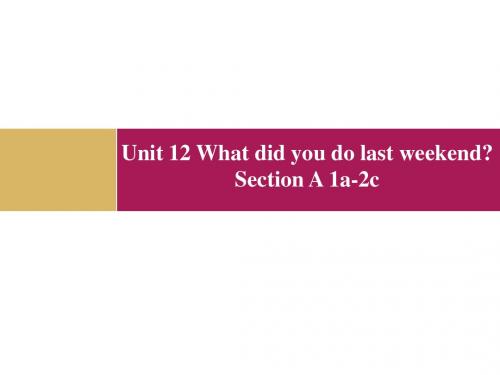
-2-
Watch the video and fill in the chart.
What did Teddy do last weekend?
Saturday morning Saturday afternoon Sunday morning Sunday afternoon
2.当谈论上个周末所做的活动时,要根据活动的_____顺序来写。 听力对话中就是按照这个顺序来交际的,写出可以使用的时间顺序: ______________; _____________;_______________; ______________;______________;_______________。
Listen again and notice the stress, sense-group pause and rhythm.
-10-
观察与思考1
1.当谈论上个周末所做的活动时,要用______________时态。 动词的过去式有__________变化和______________变化形式, 在说写的过程中一定要恰当的使用。 你能正确写出下列动词的过去式吗? go_______; do_______; camp_________; play_________; visit______; feed________; study_______; stay_______
cleaned room visited grandparents played football watched TV
-5-
camp
lake
beach
badminton
最新人教版七年级下册英语全国英语素养大赛一等奖教学设计10.2
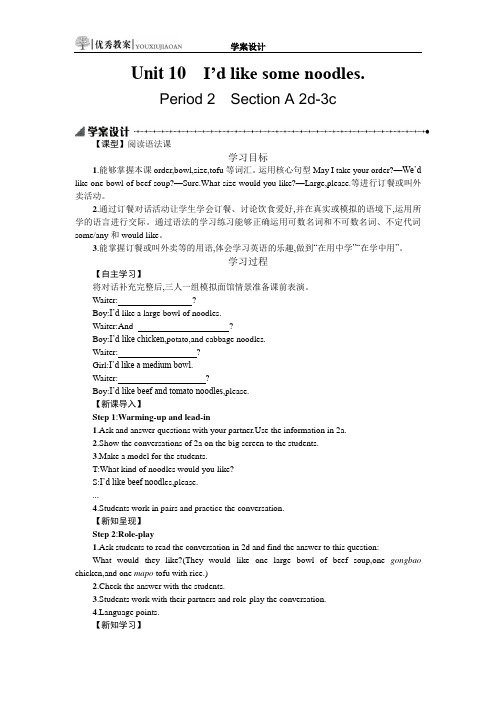
Unit 10I’d like some noodles.Period 2Section A 2d-3c【课型】阅读语法课学习目标1.能够掌握本课order,bowl,size,tofu等词汇。
运用核心句型May I take your order?—We’d like one bowl of beef soup?—Sure.What size would you like?—Large,please.等进行订餐或叫外卖活动。
2.通过订餐对话活动让学生学会订餐、讨论饮食爱好,并在真实或模拟的语境下,运用所学的语言进行交际。
通过语法的学习练习能够正确运用可数名词和不可数名词、不定代词some/any和would like。
3.能掌握订餐或叫外卖等的用语,体会学习英语的乐趣,做到“在用中学”“在学中用”。
学习过程【自主学习】将对话补充完整后,三人一组模拟面馆情景准备课前表演。
Waiter:?Boy:I’d like a large bowl of noodles.Waiter:And ?Boy:I’d like chicken,potato,and cabbage noodles.Waiter:?Girl:I’d like a medium bowl.Waiter:?Boy:I’d like beef and tomato noodles,please.【新课导入】Step 1:Warming-up and lead-in1.Ask and answer questions with your e the information in 2a.2.Show the conversations of 2a on the big screen to the students.3.Make a model for the students.T:What kind of noodles would you like?S:I’d like beef noodles,please....4.Students work in pairs and practice the conversation.【新知呈现】Step 2:Role-play1.Ask students to read the conversation in 2d and find the answer to this question:What would they like?(They would like one large bowl of beef soup,one gongbao chicken,and one mapo tofu with rice.)2.Check the answer with the students.3.Students work with their partners and role-play the conversation.nguage points.【新知学习】Step 3:Grammar Focus1.学生阅读Grammar Focus中的句子,然后做练习。
最新人教版七年级下册英语全国英语素养大赛一等奖课件新目标七下 Unit 12 Period 4课件1
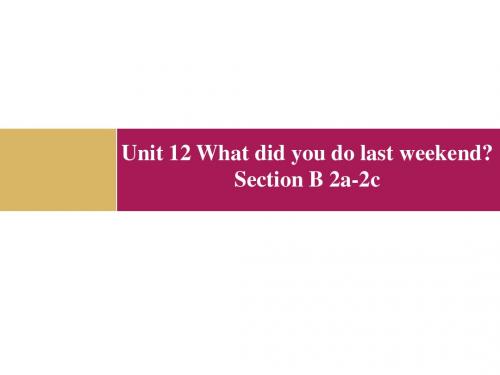
4.通过了解蛇和印度文化,拓宽视野。
-3-
Presentation
Brainstorming: Can you list animals we have learned? What kinds of animals are you sometimes afraid of? (Put a for being afraid of) Why?
Para. 1 Para. 1 Para. 2 Para. 3 Para. 2 Para. 3
A
B
3. Scan Para. 1 and answer:
-5-
When did her sister finish high school? Where did she and her family go last weekend? Key: Two weeks ago. They went to India.
4. Scan Para. 2 and Para. 3 and answer:
By what sequence was the story written? Underline the key words. Keys: time sequence (时间顺序) First; On the first night; The next morning
The next morning, Lisa’s sister and she _____ a terrible ______. When they _____ _____ _____their tent, they _____ a big snake______ near the fire. She was ______scared _____ she couldn’t_____. They ______ ______their parents to ______them ______ about the danger. Her dad ______to ______ ________ ________ ______ in their tent. This ________ the snake ________ and it ________ ________ the forest near the lake. Her dad ________ her later that snakes don’t have _______ but can _______ things ______. He also ________ her it was _________ _________ _________ go near a snake. This was a very ________ ________ for her.
人教版七下英语核心素养教案
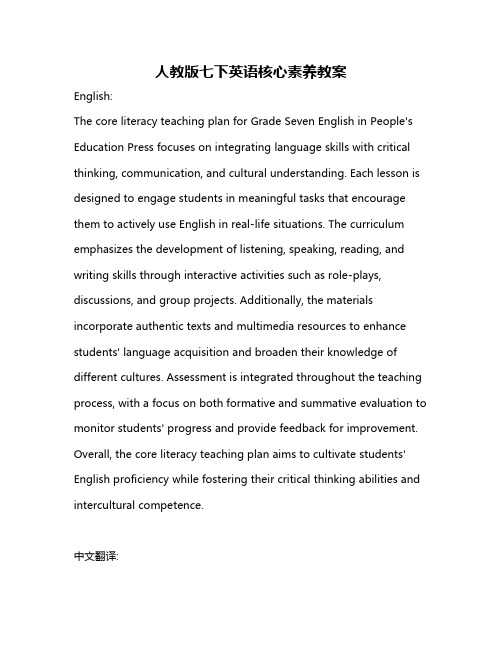
人教版七下英语核心素养教案English:The core literacy teaching plan for Grade Seven English in People's Education Press focuses on integrating language skills with critical thinking, communication, and cultural understanding. Each lesson is designed to engage students in meaningful tasks that encourage them to actively use English in real-life situations. The curriculum emphasizes the development of listening, speaking, reading, and writing skills through interactive activities such as role-plays, discussions, and group projects. Additionally, the materials incorporate authentic texts and multimedia resources to enhance students' language acquisition and broaden their knowledge of different cultures. Assessment is integrated throughout the teaching process, with a focus on both formative and summative evaluation to monitor students' progress and provide feedback for improvement. Overall, the core literacy teaching plan aims to cultivate students' English proficiency while fostering their critical thinking abilities and intercultural competence.中文翻译:人民教育出版社七年级英语核心素养教案注重将语言技能与批判性思维、沟通和文化理解相结合。
人教版初中英语七年级下册 Section A 1a—2c(全国一等奖)
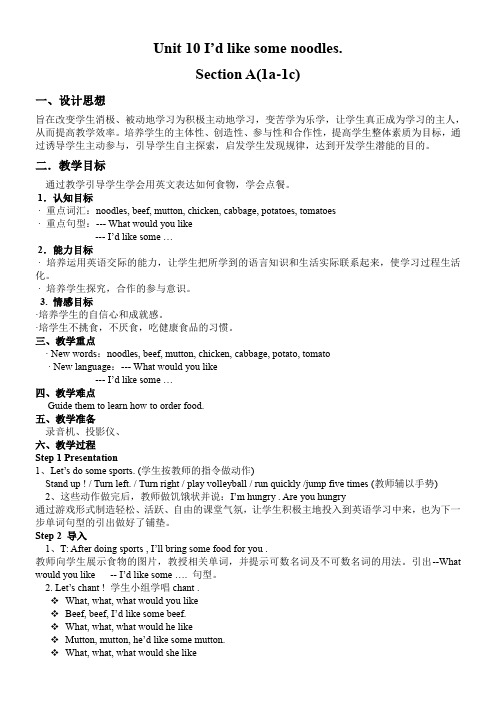
Unit 10 I’d like some noodles.Section A(1a-1c)一、设计思想旨在改变学生消极、被动地学习为积极主动地学习,变苦学为乐学,让学生真正成为学习的主人,从而提高教学效率。
培养学生的主体性、创造性、参与性和合作性,提高学生整体素质为目标,通过诱导学生主动参与,引导学生自主探索,启发学生发现规律,达到开发学生潜能的目的。
二.教学目标通过教学引导学生学会用英文表达如何食物,学会点餐。
1.认知目标· 重点词汇:noodles, beef, mutton, chicken, cabbage, potatoes, tomatoes· 重点句型:--- What would you like--- I’d like some …2.能力目标· 培养运用英语交际的能力,让学生把所学到的语言知识和生活实际联系起来,使学习过程生活化。
· 培养学生探究,合作的参与意识。
3. 情感目标·培养学生的自信心和成就感。
·培学生不挑食,不厌食,吃健康食品的习惯。
三、教学重点· New words:noodles, beef, mutton, chicken, cabbage, potato, tomato· New language:--- What would you like--- I’d like some …四、教学难点Guide them to learn how to order food.五、教学准备录音机、投影仪、六、教学过程Step 1 Presentation1、Let’s do some sports. (学生按教师的指令做动作)Stand up ! / Turn left. / Turn right / play volleyball / run quickly /jump five times (教师辅以手势)2、这些动作做完后,教师做饥饿状并说:I’m hungry . Are you hungry通过游戏形式制造轻松、活跃、自由的课堂气氛,让学生积极主地投入到英语学习中来,也为下一步单词句型的引出做好了铺垫。
人教版七年级英语下册全册教学设计【精品】
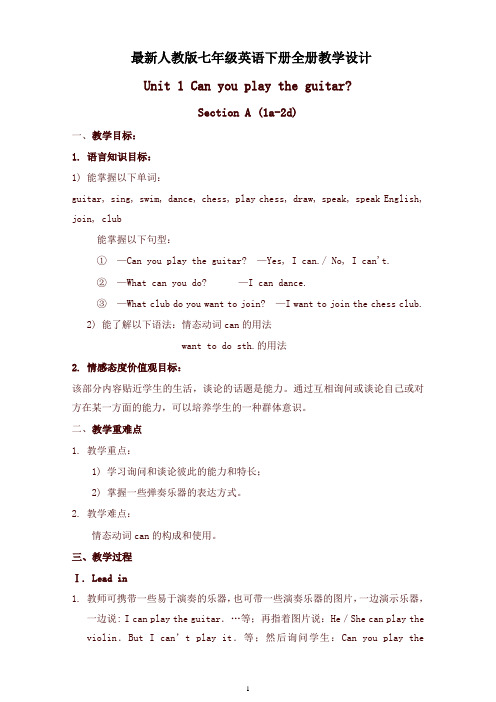
最新人教版七年级英语下册全册教学设计Unit 1 Can you play the guitar?Section A (1a-2d)一、教学目标:1. 语言知识目标:1) 能掌握以下单词:guitar, sing, swim, dance, chess, play chess, draw, speak, speak English, join, club能掌握以下句型:①—Can you play the guitar? —Yes, I can./ No, I can't.②—What can you do? —I can dance.③—What club do you want to join? —I want to join the chess club.2) 能了解以下语法:情态动词can的用法want to do sth.的用法2. 情感态度价值观目标:该部分内容贴近学生的生活,谈论的话题是能力。
通过互相询问或谈论自己或对方在某一方面的能力,可以培养学生的一种群体意识。
二、教学重难点1. 教学重点:1) 学习询问和谈论彼此的能力和特长;2) 掌握一些弹奏乐器的表达方式。
2. 教学难点:情态动词can的构成和使用。
三、教学过程Ⅰ. Lead in1. 教师可携带一些易于演奏的乐器,也可带一些演奏乐器的图片,一边演示乐器,一边说: I can play the guitar.…等;再指着图片说:He/She can play the violin.But I can’t play it.等;然后询问学生:Can you play theguitar?….并引导学生进行简单的回答。
2. Ss look at the picture in 1a. Then read the words and phrases. Let Ssmatch the activities with the people.Then Check the answers with the class together.Ⅱ. Presentation出示一些反映各种活动的图片、幻灯片或播放课件,引导学生谈论活动:He/She can dance/swim/sing/"··But I can’t dance/swim/sing/...等,学习表达活动的动词短语。
初中英语人教版七年级下册Unit 12 2d-3c 教学设计

The Second Period (Section A, 2d–3c)教学目标1学习并掌握词汇:sheep, as, natural, butterfly, visitor, tired, stay, stay up late2.学会使用一般过去时态中由who,what,where,how 进行的提问的特殊疑问句句型:What did you do last weekend?Who visited her grandma? Becky did.Where did she go last weekend? Who did she go with?She went with her classmates.3情感态度目标:通过询问同学间过去所做的事情,增进同学间的感情。
教学重难点Step 1 RevisionRevise the past forms of the verbsFree talk about what students did last weekendTalk about the pictures in pairsStep 2 Presentation1. Present the new words and teach them to read it.butterfly living habitsNatural History Museum2. Work on 2d (完成2d)a. Read the conversation and answer the following questions.1. What did Lisa do last weekend?2. As a guide, what did Lisa do in the museum?3. What did Paul do last weekend?4. How was Lisa’s weekend?b. Listen and fill the blanksStep 3. Practice1. Role-play the conversation in 2d.2. Work in pairs and talk about your own weekend activities, using what , when, where, who3. Work in groups and discussStep 4 Grammar focusStep 5. Work on 3aStep 6 Work on 3b and then tell in your own words.Step 7 Work in groups and talk about the most interesting vacation you had. Andthen showLisa’s weekend How---It was _1___________ and_2____________ What---She _____________ a guide ____the Natural history museum. There is butterfly house _________over 200__________butterflies. She told the ________ about them and their ________. Paul’s weekend How---It was good _________kind of tiring.What---He _______________ to watch the soccer game.。
人教版初中英语七年级下册 Section A 2d—3c(区一等奖)
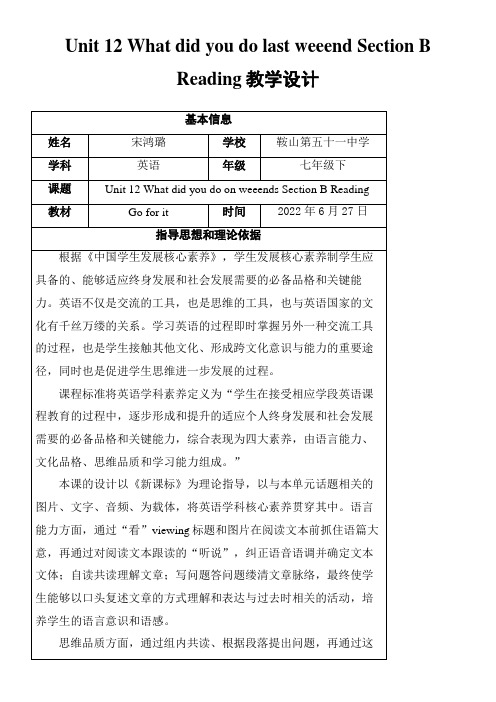
指导思想和理论依据
根据《中国学生发展核心素养》,学生发展核心素养制学生应具备的、能够适应终身发展和社会发展需要的必备品格和关键能力。英语不仅是交流的工具,也是思维的工具,也与英语国家的文化有千丝万缕的关系。学习英语的过程即时掌握另外一种交流工具的过程,也是学生接触其他文化、形成跨文化意识与能力的重要途径,同时也是促进学生思维进一步发展的过程。
ewor
根据思维导图复述课文。
【设计意图】语言汉语阅读有六要素,同样适用于英语,学生课后一致反映,思维导图就像“X”光一样,让复杂的英文,变得清晰可见,学生也非常喜欢参与课堂的过程。
但也留有很多的遗憾,课前在“备时间”上还需更加精确严谨,多给学生一些思考时间,比如回答问题环节,由学生自己观察后,自主找到问题中的语法、词汇等错误;还有最大的遗憾就是,没有充足的时间让学生在课堂上复述。
最后,恳切的期望,看到这节课的老师,不吝赐教!我希望自己能走出课堂瓶颈,多一些视角,而不是闭门造车。我希望让教学中出现在脑中的问号,得以化解;闪现在脑中的想法,得以明晰!我希望孩子们喜欢我的课堂,孩子们在快乐中收获知识,水到渠成的取得好成绩,我希望孩子们发现语言的魅力,种下一颗善的种子!
思维品质方面,通过组内共读、根据段落提出问题,再通过这些问题和“记叙文”文体的特点(六要素),绘制思维导图,展现文章脉络,提升学生分析问题和解决问题的能力。
学习能力方面,将阅读分为“读前”“读中”“读后”---读前判断文章大意,避免盲目阅读,运用“略读”的策略;读中积极思考,提出问题;读后整理思路,梳理脉络。提升英语学习效率的意识和能力,通过同学合作等培养学生自主学习,合作学习的意识。
学情分析
1虽然一般过去时有一定的基础,但动词变过去式的很多特殊变法学生还不够熟练。
- 1、下载文档前请自行甄别文档内容的完整性,平台不提供额外的编辑、内容补充、找答案等附加服务。
- 2、"仅部分预览"的文档,不可在线预览部分如存在完整性等问题,可反馈申请退款(可完整预览的文档不适用该条件!)。
- 3、如文档侵犯您的权益,请联系客服反馈,我们会尽快为您处理(人工客服工作时间:9:00-18:30)。
Unit 12What did you do last weekend?Period 2Section A 2d-3c【课型】对话表演和语法课学习目标1.通过2d的对话表演,领会一般过去时在具体语境中的运用并熟练掌握目标语言:I worked as a guide at the Natural History Museum.I told the visitors about them and their living habits.I stayed up late to watch the soccer game.2.通过语法表格,能更深入地理解一般过去时态的特殊疑问句的变化规律。
3.3a(关注语言形式),3b(关注语言意义)和3c(关注口头交际)的逐级训练,能熟练地正确地运用过去时态的各种不同句式。
学习过程【自主学习】一、预习交流(1)根据Grammar Focus,归纳Section A部分语法重点。
(2)自学2d,勾画出重点和疑惑。
二、英汉互译(1)自然历史博物馆(2)生活习性(3)担当;工作是(4)tell...about...(5)kind of tired(6)stay up late【新课导入】Step 1:Lead-in1.Greetings教师和学生互动交流周末怎么样,做了什么。
根据实际情况可用不同的活动短语,用得越多越好。
T:How was your weekend?S:It was great.T:What did you do?S:I fed some sheep....2.两两对话。
Look at the pictures and talk about the weekend.A:How was your weekend?B:It was great /OK /not bad/not very good...A:What did you do last weekend?B:...【新知呈现】Step 2:Presentation1.看图片,Lisa和Paul正在谈论他们的周末活动。
猜测他们在周末干了什么?周末过得如何?2.看图片,猜测Lisa 在干什么。
Lisa【新知学习】Step 3:Role-play the conversation.(2d)1.细读2d,回答下面的问题:Q1:How was Lisa’s weekend?Q2:Where did she go?Q3:What did she do there?Q4:What did Paul do last weekend?2.认真读课本2d,然后合上课本完成句子。
(1)interesting!(2)I’m tired.(3)I to watch the soccer game.(4)I worked a a guide at the N History Museum.(5)They have a b house with over 200 kinds of b.Step 4:Grammar Focus1.Read Grammar Focus twice.First,read after the teacher.Second,read by themselves.2.Try to recite them.Step 5:Work on 3a1.Look at 3a.Fill in the blanks with who,what,when, where or how.2.Please read aloud these conversations.Then make your own conversations by using:who,what,when,where or how.Step 6:Work on 3b1.Go through 3b quickly.plete the passage with the correct forms of the words in the box.3.选词填空。
Mr.Jones went to the mountains for a holiday.He to the train station and on the train on Sunday morning.He a new hat.He often put his head out of the window to at the mountains.But the wind pulled his hat off.He quickly threw his old bag out of the window.Some people “Why?” He ,“There’s no name and address on my hat,but there’s my name and address on my bag.”【拓展提升】竞猜活动:想一想你上周末做过的两件事,然后在黑板上画出图片,让其他学生猜测你做了什么。
(大胆展示自己的作品,踊跃猜测同学们做过的活动。
)跟踪训练一、根据2d填空。
Paul:Hi,Lisa.?Lisa:,thanks.Paul:?Lisa:I at the Natural History Museum.Paul:Really?How !Lisa:Yeah,it was fun.They have a butterfly house !I the visitors them and their .Did you have a good weekend?Paul:Yeah,it was ,but I’m tired now.I to watch the soccer game.二、按要求改写句子。
1.I went to the cinema last weekend.(对画线部分提问)you last weekend?2.Tony went to the beach yesterday.(改为一般疑问句)Tony to the beach yesterday?3.Mary fed some cows.(对画线部分提问)fed some cows?4.I played soccer on the computer last weekend.(对画线部分提问)What you on the computer last weekend?5.They had a party two days ago.(改为否定句)They a party two days ago.6.We did our homework last Friday.(改为否定句)We our homework last Friday.7.Her weekend was very interesting.(对画线部分提问)her weekend?【课堂练习】一、单词拼写。
1.Miss Li is a good(向导)for this tour.2.I think our English class was (有趣的).3.The boy (丢失)his keys last weekend.4.Baby Mouse was (害怕).5.It’s important to learn a second(语言).二、根据汉语提示完成句子。
1.上周末你做了些什么事?did you ?2.他昨天去划船了。
He .3.谁看望了她的奶奶?Who her ?4.我在自然历史博物馆做导游。
I a guide at Natural History Museum.5.我想熬夜写作业。
I want to do homework.6.丽莎告诉游客有关蝴蝶的生活习性。
Lisa told the butterflies’ .自我反思1.我能把本单元学过的一般过去时态的各种句式分别举一个例子:肯定句:.否定句:.一般疑问句及回答:?________________________________________________.特殊疑问句及回答:?____________________________________________.2.我会用不同的人称和句式来谈论周末活动,我的例句是:_______________________________________________________________________________________________3.我的易错点是:参考答案【自主学习】一、略二、(1)the Natural History Museum(2)living habits (3)work as(4)告诉……关于……(5)有点累(6)熬夜跟踪训练一、How was your weekend;Great;What did you do;worked as a guide;interesting;with over 200 kinds of butterflies;told;about; living habits;good;kind of;stayed up late二、1.What did;do2.Did;go3.Who4.did;do5.didn’t have6.didn’t do7.How was【课堂练习】一、nguage二、1.What;do last weekend2.went boating yesterday 3.visited;grandma4.worked as5.to stay up late6.visitors about;living habits。
